Trail and road running, weight training and cycling enthusiast living in London. Currently training for the Calderdale Way Ultra in June. I like to run far, do duathlon, find trails, lift things, try new kit and eat good food. Sometimes all in one day. But not always.
Don't wanna be here? Send us removal request.
Text
A stress(ful) fracture
I have my first ultra in three days. Today I also had my first physio session. And potentially discovered my first stress fracture. Brilliant.
It all began four weeks ago when I ran the Hackney Half Marathon. The race started fine but about 4 miles in my left ankle started to ache. No big deal. Not painful. Just an ache. So I carried on and finished pretty happily. It was only after sitting on the grass for twenty minutes that the pain hit me. Big time. I could barely stand on it and the mile-long walk back to Leyton station involved multiple, curse-filled stops. Sorry Laura.
The next day it was pretty bad. Google reliably informed me I had extensor tendonitis. A couple of running fwiends (Yes you, Fastpacking Guy) said the same. It’s not a real injury, apparently. Just uncomfortable and goes away on its own. Cool. Anyway, over the next few days it started to get better. A week later, I went for a run. It started to ache again a few miles in so I abandoned it after 7 miles. No big deal, I’ll just back off for another week. A week later, went for another run. It ached again but, again, no big deal. I could handle it. Even if it ached like that for the whole 50 miles of the ultra, I could handle it. Easy. But there was still that niggling doubt...
So last week I decided to go and see my GP. Just to mention it. No big deal. He said it was probably just a tendon thing (of course, that’s what Google said!) and referred me to a physio to get a plan of action before the race.
Today I went to see the physio. I kind of wish I hadn’t. Things I expected her to say were: “it’ll be fine;” and “it’s no big deal.” Things I didn’t expect her to say were: “it could be a stress fracture;” or “I’m referring you for a CT scan.” And definitely not: “in my opinion you shouldn’t run on Saturday.”
Now she did make it clear that she was being overly cautious. And who can blame her? Telling me to crack on (no pun intended) doesn’t benefit her in any way. If it does make things worse she could be in the firing line. Plus, she also said it’s ultimately down to my judgement. Which is what worries me.
So here I am wondering what to do. I’m a touch stressed, I’m not going to lie. If I’m honest, my sensible side tells me to pull out. But the other 95 per cent of me is saying it’ll be okay. Don’t get me wrong, it’s going to hurt. Running 50 miles hurts. Everything’s going to hurt. The key is knowing the difference between discomfort and injury, right?
If I have to pull out mid-race, I have to pull out mid-race. The thought of a DNF doesn’t really bother me. I know what I’m capable of and if I have to quit due to injury, so be it. That’s very different to quitting because, well, I quit.
Plus, it’s a big deal. It’s my first ultra. I’m doing it with two good friends. It’s a few hundred miles away and we’re camping so making a weekend of it. If it was a local half marathon I’d pull out in a shot. But this is different.
Worse case scenario? It is a stress fracture. I make it worse. I have to stop running for a while. Maybe even 6 weeks. If I finish the ultra, I’ll be taking a few weeks off to recover anyway so…
That all said, I should make one thing clear - I am fully aware that I’m telling myself what I want to hear. I’m no fool. Well, not that sort of fool anyway.
1 note
·
View note
Text
Race report: Run Hackney 2015
Last November, on a whim, I signed myself and Laura up for the Vitality Run Hackney Half Marathon. The idea was for both of us to use it as a training goal. Although one of us ended up doing a bit more training than the other...
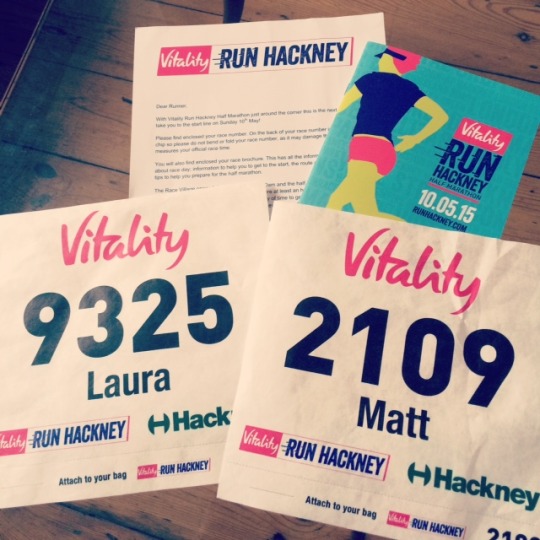
It’s not that Laura’s not good at running. Quite the opposite, I’d say that she’s actually a natural. The issue is more that she really doesn’t like it. At all. And that is why she’s only been out running four times... In the six months since I booked the race. Granted, there was an eight and a ten miler. But still.
Anyway, Laura’s training plans aside, I’ve been really excited about this one for a while. I’d heard great things about the race, the route, and the atmosphere. None of which disappointed on the day.
After an early start, we got the tube to Leyton ready for the 9am gun. As the first tube didn’t leave Clapham until just after 7am, we didn’t arrive until 8:25. Not ideal, but what can you do. Despite the moody forecast, the sun was shining and the race village was teeming with runners. We had just enough time to drop our bags off (which didn’t take long at all) and get into the pen, ready to start.
The plan was to run this one together. As I’m training for an ultra in June, I wasn’t too worried about setting any PBs. And with Laura’s somewhat renegade approach to training in mind, we opted for the 2:00 - 2:15 group, aiming to average around a 9:15 min/mile and come in at 2 hours. Perhaps a little optimistic but you’ve got to aim high, hey.
As we were a little later arriving, getting into the starting pen involved jumping over the barricade as there was already thousands of people queueing up to start. To be honest I think we both underestimated the sheer number running in the event, but once in the crowd you really felt a part of something big. As in 13,000 runners big.
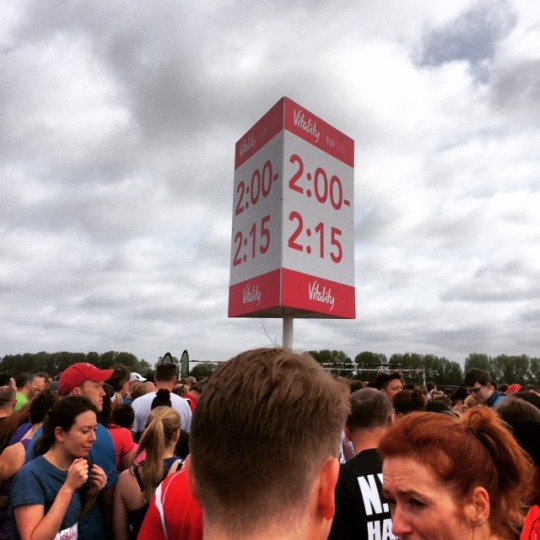
Being towards the middle of the pack, we crossed the start line about 10 minutes after the gun went off and got going at a steady 9 minute mile. The first mile was incredible. Hundreds of people lined the street, with steel bands giving it a real carnival feel and even the odd drone overhead. We barely even noticed the first few miles as we wound around Hackney Downs into Hackney Central, there was so much to keep us occupied. The next couple of miles went the same way, with us completing the first 6 miles at an average pace of 9:01 - under target and Laura’s fastest 10k yet.
The quicker-than-expected first half worked in our favour as our pace started to gradually slow down over the next few miles, which was no great surprise. But the road-side support didn’t let up. Short of the London Marathon, I doubt you’d get that sort of atmosphere in any other race in London. The regular water stations were also well organised and timed, as was the critical (albeit slightly sticky) Lucozade stop 9 miles in.
The final two miles went through the Olympic Park and a much needed mist shower. The sun had been relentless and there was no shade for this stretch, causing a few people to start dropping at various points around us. This was probably the toughest part of the run, and the lack of support here after the community feel of the streets was really noticeable. But before we knew it, the end was in sight, with a final stretch leading to the finish with more cheers either side.
Having crossed the finish line, we grabbed our goodie bag (with a great assortment of snacks in!), medal and brilliant Brooks technical t-shirt and went to have a lie down on the grass.

A very happy finisher
Overall, this was a top notch event. The marshalling, organisation and atmosphere were faultless and we were both impressed with the swag bag, medal and tee. All were really well designed and completely justified the £40 entry fee.

S.W.A.G.
Oh, and in case you wondered, we finished in 02:08:15. Not a bad effort for someone that doesn’t run. 😉
Would Laura run another half? Apparently not. Never, ever again. But we’ll see.
Pre-registration for next year’s Run Hackney is now open if you’re keen. I for one will be there. And I might even go for that PB next time round.
0 notes
Photo

I've had worse runs home... (at Chelsea Harbour Pier)
1 note
·
View note
Text
My GPS Fenix-tion
This morning my Garmin Fenix 2 GPS watch decided to stop recording my activity, mid-run. Obviously I had a meltdown, stopped running and spent the next ten minutes frantically pressing buttons and cursing while the morning commuters filed past giving me sideways looks.
I think I may have an addiction to GPS.
It’s a pretty quick run into work for me. 5 miles along the Thames. I do it most days and my pace and time stay fairly consistent. In fact, nothing ever changes. Ever. So why when my Garmin froze after 3.2 miles did I not just shrug, keep going and enjoy the run?
It kind of made me think - am I too reliant on the post-run stats? Do I really need a watch to tell me if I had a good run? Or if I’m going to fast?

I LOVE data. Really, I do. The first thing I do, before absolutely anything else, when I get in from a run, is upload it to Garmin Connect and then pore over it, reviewing every single element. When I’m done with that, I’ll do the same in Strava, checking the slightly different outputs in there. Actually, when you put it that way, it is a bit much, hey.
So, tonight I might just be a bit crazy. Tonight I might run 10k home, leave the Garmin in my bag and enjoy the sights that London has to offer. Forget about pace and elevation. Ignore the little virtual runner telling me that he’s close to catching up with me. Lose the segments and PRs.
Or I might not. I only need to log another 30 kilometers on Strava to get my ‘200k in March’ badge so every mile counts. Plus, if I don’t log runs how will I ever know how many miles my shoes have done? I’d have to actually use my instincts to see if they’re starting to feel worn out.
Never mind, I’ll just keep embracing the data. I've got nothing to prove.
If it isn't recorded, it doesn't count.
0 notes
Text
Race report: Richmond Park 10k
When my alarm went off at 7am on Saturday morning for the Richmond Park 10k, I had a quick look out of the window to try and gauge what to wear.
It was snowing. In London.
Needless to say, it didn't last long. But the temperature stuck around zero all morning. Definitely tights weather.
I had a bit of company for this race as Laura was doing it with me. Completely underestimating the amount of traffic, we got there far too early, collected our chips and race numbers, and had a good look about.
There was a pretty good turnout. Not the 400 that had registered (probably due to the freezing weather and sleet) but easily around 250. The race kicked off at 10.10 sharp and we left with the last wave and fell into a comfortable pace.
The route was two undulating laps of a 5k circuit, pretty much exclusively on muddy trails and fells, with a tiny section of pathway. Perfect terrain to give my new Brookes Adrenaline ASRs a spin. Not quite so good for Laura and her road trainers...
The course was beautiful, just open parkland, roaming deer and no cars - something I really miss living in London. It was also nice to run an organised XC as most races around here are almost exclusively tarmac.
Anyway, after sticking to just under a 9 minute mile throughout, we finished mid-pack and grabbed our medals before heading home. It was a simple, no-nonsense event. Run by The Fix Events, it was well organised, signposted and marshalled.
My first event of 2015 and a great way to start the year. Looking forward to doing another of their events in March - the Greenwich Park 15k. That'll be another good training run for Laura too. Hackney Half Marathon is slowly approaching...

0 notes
Text
Salted caramel & peanut protein flapjacks
One thing I've noticed when out on a really long run is how hungry I get, and how sugary energy gels just don't do the job. As I always have a backpack with me, taking food isn't a problem. But as I don't get on brilliantly with wheat, finding decent snacks (besides nuts) is.
So to get around this, my current favourite thing is baking flapjacks at home! They're great to take out on a run, snack on at work or just generally eat whenever you get a bit peckish.
The recipe below is one of many I've been experimenting with recently. With this one, I decided to add whey powder. This not only supplies your muscles with much needed protein (which many carb-heavy snacks generally lack) but also opens up a world of flavours.

Ingredients
180g oats (I use gluten-free)
90g whey powder (I used salted caramel flavour as that's what I had in the cupboard but any will do within reason.... Go crazy. )
90g peanut butter
20g honey
150ml skimmed milk
You'll also need...
Large mixing bowl
Baking tray or sandwich tin
Greaseproof paper
Add the oats and whey to a bowl and mix together with a spoon. Once mixed, add the milk, peanut butter and honey and give it a really stir making sure the mixture is completely even.
Line your tray with greaseproof paper and spoon in the mixture, spreading evenly. It is quite sticky so a flat spatula can help to smooth it all out.
Chuck the tray in the fridge for 20 minutes or so to help it set. While it's in there, preheat the oven to 180°C (this is for a fan oven, go for about 220°C if not).
Bake the flapjacks for 15-20 minutes. You'll know they're done when they start to turn a nice, golden colour.
Once they're done, let them cool for a bit then cut into handy pieces to take on your next trip. I tend to cut the tray in to 9 which means each square provides roughly:
190 calories
16g of carbs (3g from sugars)
7g of fat
14g of protein
Similar to a lot of 'protein bars' on the market but much cheaper. And much less sugar. Perfect.
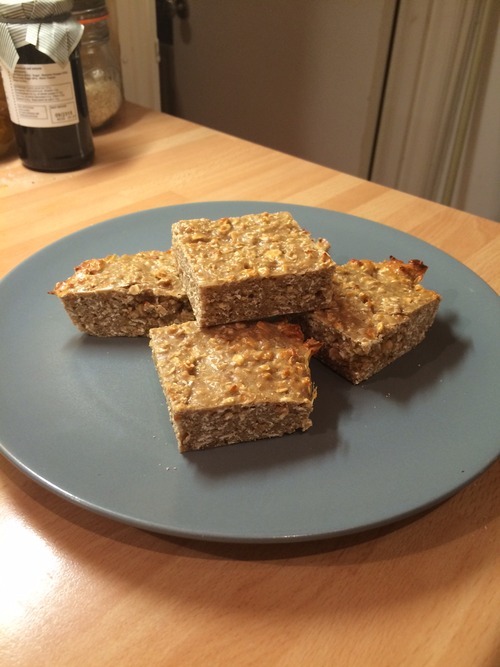
1 note
·
View note
Text
Day four: shoulders, traps and abs
Day four of my four day, body part split.
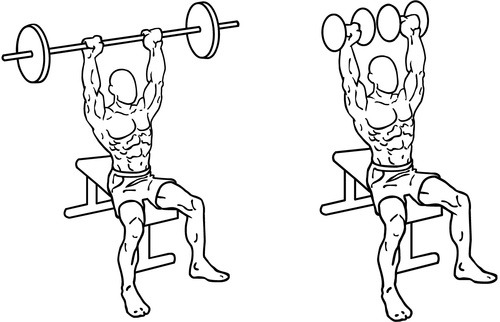
Both barbells and dumbbells play a part in shoulder training
Shoulders could be my least favourite body part to train. I don't know why. There's no actual reason for feeling this way. I just find them a bit dull.
I've had a recurring shoulder injury for years. It's not a big issue, just a slight twinge every few months, but it does potentially stop me from going too heavy on my shoulders. That said, I still give them a thorough workout, as you'll see from today's routine. I also try and throw a bit of traps in with either shoulders or back. This time, it's shoulders.
Abs may be one of my more neglected body parts when it comes to spending entire sessions on them. I think that they get a good workout from other exercises such as squats and deadlifts. Generally, I also do one or two ab exercise at the end of each full body.
Warm up
Rowing machine, level 8 – 3 minutes Dynamic stretching and mobility drills – 5 minutes
Shoulders
Machine plate press - 4 x 6 Dumbell seated press - 4 x 8 Laying lat raise - 3 x 10 Bent over raise- 3 x 12
Traps
Barbell shrug - 4 x 10 Upright row - 3 x 12
Abs
Ab wheel rollout- 3 x 15 Barbell lying leg raise - 3 x 12 Toe to bar - 3 x AMRAP
So there we have it. My four day split.
After taking a rest day on day five, you can repeat the routine again for the next four days. Or do two days on/one day off/two days on and repeat. I only chose to do four days in a row as I'd had 8 days off.
You can happily repeat the routine for 6 - 8 weeks. Then, depending on how your body is feeling, you might want to rest or deload for a week.
Give it bash and let me know how you get on.
0 notes
Text
Day three: legs
Day three of my four day, body part split.
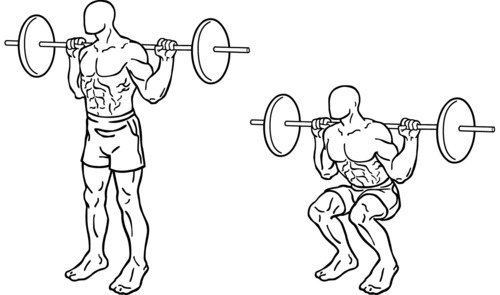
Squats. You either love them or hate them…
I’ve had a love/hate relationship with leg sessions over the years. These days, I really love training them. But I didn’t used to.
The gym I properly started training in only had dumbbells and a smith machine. Whilst you can train legs with dumbbells, it never seemed entirely comfortable. And I always felt that a smith machine locks you into an unnatural movement. So I never really enjoyed leg sessions then.
Now though I’m much more fortunate, have a wealth of kit in my gym and legs are one of my favourites. As mentioned previously, the main reason I don’t tend to do a dedicated ‘leg day’ anymore is because i love to run and cycle. And three-day DOMS aren’t particularly conducive to regular running. Ah well, I’ll take a chance this time.
So, here’s today’s leg session. There’s a lot to fit in with legs - you want to hit quads, hams and calfs so it can be a gruelling session.
Warm up
Rowing machine, level 8 – 3 minutes Dynamic stretching and mobility drills – 5 minutes
Quads
45 degree leg press - 4 x 15 Barbell back squat - 4 x 8 Barbell lunge - 3 x 10 Seated leg extension - 4 x 12
Hamstrings
Straight leg deadlift - 4 x 8 Lying hamstring curl - 3 x 12 Seated curl - 3x10
Calfs
Seated calf raise - 4 x 15 Leg press calf raise - 3 x 12
That’s it. Should be fun cycling to work in the morning.
Tomorrow - Last day: shoulders and abs.
0 notes
Text
Day two: back and biceps
Day two of my four day, body part split.

Pull-ups and chin-ups are an important addition to back and bicep sessions
I love training back. I love the variety of exercises available and I love the amount of tension you can place the muscle under. For that reason, I tend to do more exercises for back than other upper body parts, such as chest or shoulders. Your back makes up around 30% of your body, so in my opinion can handle more work than smaller body parts.
Warm up
Rowing machine, level 8 – 3 minutes Dynamic stretching and mobility drills – 5 minutes
Back
Barbell wide-grip row - 4 x 6 Weighted pull-up - 4 x 6 One-arm dumbbell row - 4 x 8 Neutral cable pull down- 4 x 8 Cable row - 3 x 12 Straight-arm pulldown - 3 x 12
Biceps
Standing dumbbell curls - 4 x 8 Standing EZ bar curls - 3 x 12 Close-grip chin-up - 3 x AMRAP
Again, tempo pretty slow throughout. Rest 60 seconds on lower rep sets and 90 seconds on higher.
Tomorrow - Legs. Eek.
0 notes
Text
Day one: chest and triceps
Day one of my four day, body part split.
In my previous post, I mentioned that I generally prefer full body training. However, in the interests of variety, for the next four days I’ll be training using a body part split…
Read on for part one of my four part routine...
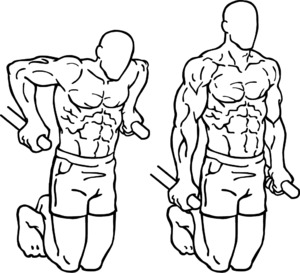
Dips are one of my favourite chest and tricep exercises
Unlike most of the ‘bros’ out there, I don’t hugely enjoy training chest. ‘Chest Monday’ isn’t my bag and I never spend an entire session hanging out by the olympic bench.
But having said that, a split does allow for a good mix of different chest exercises to keep it interesting, so I was quite looking forward to this one.
Warm up
Rowing machine, level 8 – 3 minutes Dynamic stretching and mobility drills – 5 minutes
Chest
Incline barbell bench press - 5 x 6 Flat dumbbell bench press - 4 x 8 Decline barbell bench press - 3 x 12 Wide-grip weighted dips - 4 x 8 Cable crossovers - 3 x 12
Triceps
Weighted machine dips - 4 x 8 Cable press down - 4 x 12 Diamond press-up - 4 x AMRAP
I kept the tempo pretty slow throughout - at least a 2 or 3 second eccentric (lowering) phase.
Rest-wise, I aimed for 60-90 seconds on the sets of 6 or 8, and 120 seconds for the sets of 12.
Next up - Saturday morning back and biceps. My favourite.
1 note
·
View note
Text
A change is better than a rest

A fresh routine after taking a bit of time off can renew your enthusiasm
I've just got back from an amazing long weekend on a narrowboat. Unfortunately, after spending four days navigating the slightly damp Grand Union Canal, I returned with a touch of flu. Winner.
Still, not to worry. These things happen and, as I'm starting to feel a bit better today, I'm aiming to get back in the gym tomorrow morning before work.
I currently favour a full body training routine over a body part split. I've tried most styles of training over the years and, while they've all yielded good results, full body just fits better for me at the moment (I also throw in an upper/lower quite often but that's for another post).
Why?
The main reason is volume. I can hit every body part three times a week using just three full body sessions. This allow me to dedicate time to the other disciplines I enjoy, such as running and cycling. With a body part split, you invariably have to hit the gym five or six times a week to get everything in.
However...
I haven't trained for 8 days and I fancy a bit of variety, so I've decided to deviate from my current rotating full body split, to a body part split for the next four days.
Switching routine after taking a bit of time off always renews my enthusiasm and allows me to throw in some exercises I haven't used for a while.
So, my split will be:
Friday - Chest and triceps
Saturday - Back and biceps
Sunday - Legs
Monday - Shoulders and abs
After this, I'll probably have a rest day on Tuesday before going back into a full body on Wednesday.
Looking forward to getting back into it - I'll post the first routine on here tomorrow.
4 notes
·
View notes
Text
Obstacle course racing - Does it really matter what you wear?
The short answer? Yes.
In the weeks leading up to Tough Mudder, or any other Obstacle Course Race (OCR), people generally have a few questions. But the main one, by far, is “what do I wear?”
On the day of the event, the most important thing is your choice of clothing. Get it wrong and those 12 miles are going to feel like 12 hundred.
Here’s some advice when it comes to picking your kit for the big day.
Top
What you wear on your upper body is key. The number one rule is to avoid cotton like the plague. Within the first 20 minutes you will be soaking wet, and cotton will simply absorb the water, making it heavy. It will also stay wet, and cold, for the entire run, leaving you feeling pretty wretched. The other thing to avoid is anything too baggy. There are so many obstacles to snag your clothes on, your top wants to be as form-fitting as comfortably possible.
Overall, a compression-style top is the smart choice, something by the likes of Nike Pro Combat or Under Armour. As they fit like a second skin, your body heat will dry these ridiculously quickly - something you'll be particularly glad of after obstacles like Arctic Enema or Walk the Plank.
Whether you go for long or short sleeves is really up to you. Long sleeves are preferable in the colder weather and also protect your arms a little whilst climbing over, or crawling under, obstacles.

Nike Pro Combat Core Compression t-shirt
Shorts/Leggings
Again, as you want something tight and quick drying, compression shorts or leggings are the way forward. They wick the water away from your skin, keeping you dry and comfortable. Just don’t wear anything underneath or you’ll lose any benefit.
As mentioned above, Nike Pro Combat and Under Armour have a good range of compression gear. Fit-wise, just select your usual underwear size and you should be fine. Many people choose to wear other shorts on top to preserve their modesty - any lightweight running shorts are perfect.
Socks
Having dry feet will have a huge impact on your day. Sloshing about in wet socks for three-plus hours is utterly miserable. Once again, the golden rule is to AVOID COTTON socks. They’ll absorb the water and give you blisters. Rubbish.
Woollen socks are the perfect choice as not only do they repel water, they also retain heat. Merino wool, in particular, is excellent. Something like X-Socks Winter Run are ideal, keeping feet warm and dry throughout.
Shoes
Depending on who you speak to, you’ll generally get one of two views when it comes to footwear.
One camp say that any running shoes are fine. They provide adequate grip (apart from in the really muddy parts where you will be sliding about a bit) and most people will have a pair already, saving the expense of buying anything else. They also clean up pretty well afterwards, as most of the mud gets washed off by the end of the run.
The other option is trail shoes. If you intend to run OCRs regularly, or generally enjoy running trails, then these will increase your grip and might reduce the risk of you slipping or rolling your ankle. Inov-8 make a good range of OCR-friendly trail shoes.
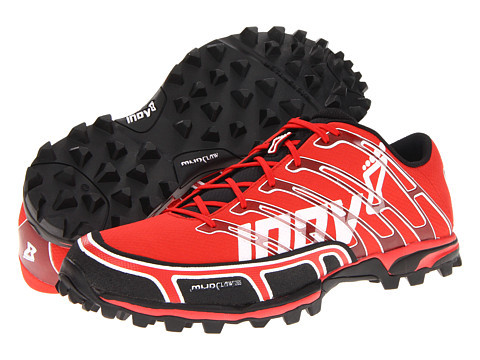
Inov-8 Mudclaw 265
Gloves
This one comes down to personal preference. If you’re not a huge fan, and think you’ll have a better grip with your bare hands, then go without. That said, in the winter months you may want a pair to keep your hands warm. A waterproof and rubbery material, like neoprene, is best. Polyco Mad Grip are a popular choice and priced very reasonably.
Oh, and finally - don’t forget to take a bin bag and some dry clothes to change into. Your car will thank you for it.
2 notes
·
View notes
Text
The neglected fixie: Part two
Recently I wrote about my poor old fixie. Always the bridesmaid etc.
It was only after giving it a good clean last week that I realised just how battered it was. Having only replaced the brake pads, tyres and the rear wheel in the five years I’ve had it, I feared the worst.
Anyway, a trip to Balfe’s Bikes in Kennington and £100 later, it had been degreased and reassembled, the wheels had been trued, and it had new brake pads, bar tape, chainring, chain and rear sprocket. Lucky bugger.
I also took the opportunity to upsize the gear ratio – something I’ve wanted to do for absolutely ages. My commute is pretty flat and I find myself spinning quite a bit. So I’ve gone from 44 teeth on the front chainring and 18 teeth on the rear sprocket (44/18) to 46 and 16 respectively.

New front chainring
Basically, the bigger the difference (or ratio) between the two, the harder it is to pedal but the faster you can go once you get moving. That’s why track bikes used in a velodrome have enormous front chainrings. And track riders have enormous legs. My old ratio was 2.44 to 1, the new ratio is 2.88 to 1. Quite a jump.

A somewhat extreme example...
I’ve only taken it for a short ride so far and the bigger gear was definitely noticeable. Great for training my quads, not so great for racing off the lights. You can’t win ‘em all.
1 note
·
View note
Photo

Bigger chainring + smaller sprocket = faster fixie and devastated quads.
0 notes
Text
The neglected fixie: Part one
I feel quite sorry for my fixie.
It’s a Felt Dispatch that I've had for just over five years and, in that time, it’s taken quite a hammering. For the last three years it’s been my daily commuter, taking me into central London and back, five times a week. All in all, I probably cover between 60 and 80 miles a week on it - around 4000 miles a year. It’s also left outside my office, locked up on the main road, in all kinds of weather. Snow, rain, hail – you name it.
Poor little guy.

Now, you’d probably assume that, as I use it so much, it gets looked after. Unfortunately not. It’s always been the poor cousin, particularly as I now have a Felt Z6 road bike which I’m a little bit in love with. It gets treated like carbon-clad royalty - only taken out on dry days, NEVER left locked up, and often stared at lovingly from across the front room.
Anyway, last week I decided enough’s enough. I like to think I’m a fair man and my poor fixie has been neglected. There. I said it.
To start making amends, I gave the frame a good wash on Saturday, trying to reveal the white(ish) paintwork under the accumulated Zone One grime, as well as getting all the brake dust off the rims and attempting to degrease the chain. Once clean, it looked much better. Still incredibly sorry for itself. But better. Next, after hearing great reviews, I gave Balfe’s Bikes in Kennington a shout and booked it in for a much needed service. Unlike many other bike shops, they take a common-sense approach to single speed/fixie servicing and charge less for that than a geared bike. How refreshing.
I've even got some new bar tape to replace the ripped and grubby excuse it’s currently sporting. How’s that for pampering?
Having dropped it off this morning, I’m intrigued to know what needs to done. Probably a fair bit as, other than brake pads and tyres, no parts have been replaced in years. Whilst there (I don’t do things by halves...) I also asked about increasing the gear ratio - my commute is quite flat and I’d like to get a bit more top end out of it. So it should come back a new beast.
I’m picking it up after work tonight. ‘citing. Will update later.
2 notes
·
View notes
Text
Simple upper body routine
I’m going to the gym at lunchtime and, as I’m against the clock, I want to make it quite intense. I’ll be keeping rest to a minimum – under 60 seconds between sets – to get as much in as I can.
As I recently tore a ligament in my left knee, I’m giving my lower body a rest at the moment and just training upper body. I haven’t been able to train legs for three weeks now and it’s getting a bit frustrating. Hopefully, after resting it for another week or so, I’ll be able to start slowly working lower body back in.
So anyway, today’s routine...
A nice, simple upper body session. Nothing fancy, just slightly varied rep and set ranges, focusing mainly on compound moves, and keeping the target muscle under tension throughout.
Warm up:
Rowing machine, level 8 – 3 minutes Dynamic stretching and mobility drills – 5 minutes
Narrow grip lat pull down – 4 x 8 Wide grip T-Bar row – 3 x 12
Barbell incline bench press – 4 x 8 Wide grip weighted dips – 3 x 12
Barbell military press – 4 x 8
Alternating dumbbell curl – 3 x 10
V-bar cable press down – 3 x 10
Toes to bar – 3 x AMRAP
So that’s it. Once my knee is back in business, I’ll be switching over to a full body routine, 3 to 4 times a week. As always, I’ll post my routines on here for anyone that’s interested.
Cheers.
0 notes
Text
Race report: London Duathlon 2014 - a walk in the park?
I'm a cyclist. I'm a runner. But does that automatically make me a duathlete?
Part of the reason I entered the 2014 London Duathlon was to find out.
The idea of doing a triathlon has appealed to me for quite some time. The only thing that really held me back was finding the time to commit to swimming more often. I'm not a bad swimmer, but my technique is far from perfect and it needs some work. This is one of my goals for the next year but anyway, I digress. I first heard about the London Duathlon earlier this year and, on a whim, decided to enter the sprint distance. I like having something to train towards and the 10km run/22km ride/5km run seemed the perfect distance to (not) dip my toe in the water.
To say that training didn't go to plan is a slight understatement. Three weeks before the event I came off my bike and my left knee took a fair hammering. It wasn't a particularly glamorous affair. A car slammed its brakes on in front of me and I couldn't get out of my SPDs in time. Cue frantic and slightly desperate wriggling of legs before hitting the deck with all the grace of an elderly rhino. Winner. Anyway, after still not being able to run on it for 10 days I went to my GP who said I'd torn a ligament in my knee. His advice was to rest it for several weeks. I chose not to listen to that and tried to jog home from the surgery. It hurt. A lot. Damn.
Anyway, fast forward a few days and it started to feel much better. I didn't risk running on it before the race so as to give it as long to heal as possible and, come race day, it felt okay. Not amazing but okay. The only downside was that I felt completely unprepared and nowhere near as fit as I wanted to be. I hadn't even practiced switching from running to cycling, back to running, known as a ‘brick’ session. But not to worry. I decided to just enjoy the day and not aim for any PBs.
Sorting my kit out the day before, I had the usual debate about what to wear. I'd bought some great 2XU triathlon shorts from Wiggle beforehand which were incredibly comfortable to run and cycle in. Similar to cycling shorts but far less padding. So that was fine. However the main dilemma was what top to wear. Cycling jersey or running t-shirt? I find running in a cycling jersey irritating as it rides up at the back. But it does have pockets for gels etc. Running t-shirt is more comfortable but flaps about a bit on the bike. In the end I found the perfect compromise - a Nike Pro compression top. Nice tight fit and comfortable for both running and cycling. Smashing. I decided I could live without pockets. It's not a particularly long event and I have them in the back of my shorts anyway.
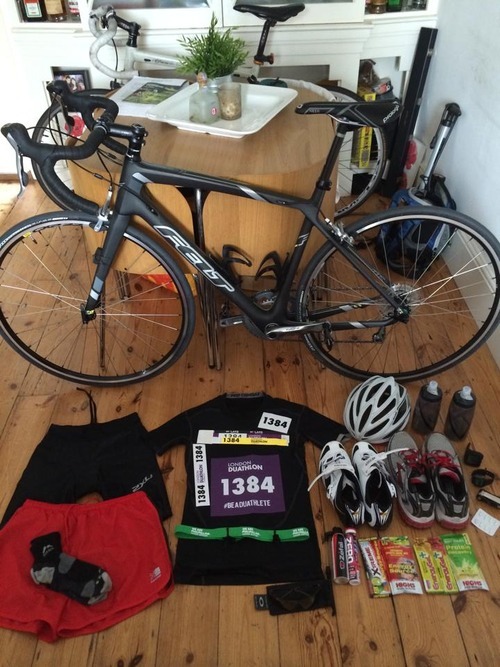
My kit all lined-up the day before the race. Geek
I was up early on the day of the race and it was a perfect morning. Warm but not hot and sunny but not bright. Couldn't have asked for more. After cycling the 5 miles to Richmond Park (managing to not get stuck in my pedals) I arrived at the already bustling event village and, having never set up for transition before, apprehensively made my way to the transition area. I needn't have worried. The marshals couldn't have been more helpful and after checking my wristband and brakes, they showed me where (I chose rack 7 as my birthday is 7/7 so I thought I’d remember that) and how to rack my bike. My other half kindly came along to support me so once I’d lined my cycling shoes and High5 gels up, I went to meet her back in the event village ready for my 9am start.
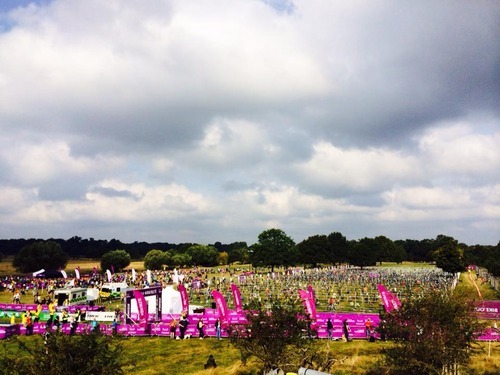
The event village with transition area to the right
We had a little look around the event village which had everything you’d expect. Several food stands, ranging from smoothies to jacket potatoes, bike mechanics for last minute services, lots of portaloos, and plenty of free bottles of water placed about the site.
After watching the Ultra distance runners set off (all doing a casual 20km/77km/10km!), I was called to the start. Whilst waiting in the crowd of other competitors doing the sprint distance, what really struck me was the huge mix of ages and abilities. It ranged from people doing it for fun (I heard one couple saying how they were looking forward to having a few beers and a cigarette afterwards...) all the way to some pretty serious looking pros in full triathlon suits. But the one thing that everyone had in common was they were really up for it. The buzz in the crowd was tangible and no-one seemed at all nervous, just excited.
We were split into groups of 25, due to the narrow start area, and given a quick safety chat. After three starting beeps on the tannoy, we were off. I’d already decided to stick to a gentle pace of around a 5 minute km for the first 10km so I set off at this speed and naturally fell into step with some of the other runners around me. I struck up conversation with a guy next to me and we ended up chatting for the first couple of kilometres. He was also recovering from an injury so had a similar mentality to me when it came to the race. The run was fairly flat, with the odd hill here and there and all-in-all it was a beautiful route.
After covering the width of Richmond Park along Sawyers Hill, we looped back through Deer Park towards the transition area. My knee felt surprisingly good and I fell into a comfortable rhythm, getting back to the transition area in 50:08, an almost spot on 5 min/km pace.

Running into transition after the first 10km
Transition one was a doddle. My main concern leading up to it was forgetting to put my helmet on before unracking my bike – which incurs a two minute penalty. But as I was so conscious of that, I was fine. My bike was racked right by the entrance from the run so it was helmet on, running shoes off, cycling shoes on, grab bike, go. I didn’t feel that I was at the level where I needed to leave my cycling shoes clipped in and run barefoot with the bike. It does save time but I had visions of messing around trying to get my shoes fastened for ages and actually losing more time. Plus the recent fight with my SPDs was still quite fresh in my mind... So after completing T1 in 01:13, I ran my bike up to the line, jumped on and started pedaling.
Now, leading up to the event I’d been looking at the ride as the ‘nice bit’ between the two runs. “It’s only 22 km” I thought, “just two laps of the park. Nice chance to take on liquid, make up some time, and let your legs recover for the last 5km.”
I couldn't have been more wrong.
The first couple of kilometres weren't too bad and seemed to gradually slope downhill but then I hit a monster hill. It was a killer. After that there were some nice downhill sections but generally, the ride seemed to get tougher all the way back to the event village. By the time I finished my second lap I was actually looking forward to getting off the bike. Whilst thinking how much I'd changed my tune, I jumped off my bike and jogged with it into transition, after a longer than expected 46:37.
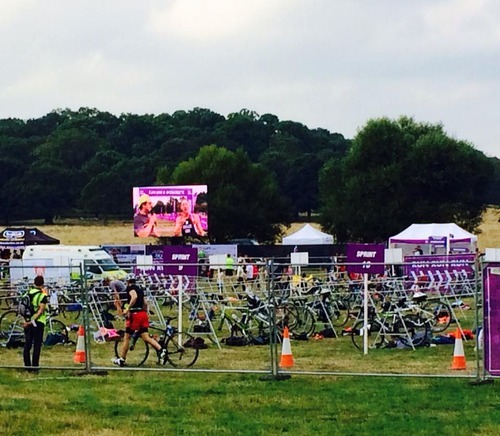
Running my bike into T2 while feeling mildly confused
Unfortunately transition two wasn't quite as simple as T1. As I ran my bike in, feeling slightly disorientated, I found rack number 7 and looked for my bag. It wasn't there. I checked the number again. Nope, definitely no bag or shoes. What’s going on? After what seemed like an eternity, but was probably only about 10 seconds, it dawned on me – my stuff was at the other end of the rack! Idiot. Once I’d found my kit and racked my bike, I fumbled my shoes on and set off for the final run after a much longer transition time of 02:33. This is where it got really interesting...
I’d read about the phenomenon known as ‘jelly legs’ beforehand, but never experienced it firsthand. This is simply your muscles getting used to doing a new activity, as cycling and running use different leg muscles, and I’d advise practicing this switch beforehand to get used to the feeling. As mentioned, I hadn’t done any brick sessions in training so this was new to me.
It felt bizarre and the first two kilometres of the 5km were really hard. Like, really, really hard. This was where the race marshals excelled. All the way along the 5km route they were cheering people on, shouting encouragement through their megaphones, and generally being thoroughly nice. A great team and a testament to the London Duathlon organisers. There were also plenty of drink stations providing water and Lucozade along the route. Around 3kms in, I found my legs again and settled back into my pace, crossing the finish line in an okay 24:23 to a medal, banana, very nice technical t-shirt and beaming girlfriend.
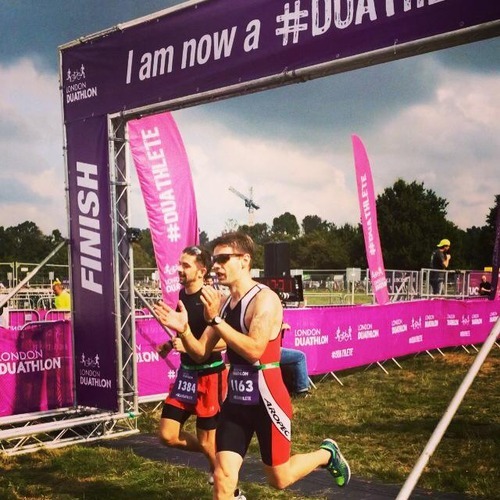
Crossing the finish line. Hooray
Overall, I loved this event. It was incredibly well run and organised. The event facilities left you wanting for nothing. The route was beautiful and the fact it was traffic free was an added bonus. I even saw a few deer. Lovely stuff.
The main learning point I’d take away is to really familiarise yourself with the transition area. Coming in after a run or ride you’re tired and disorientated so it helps to know where you’re going. In future, I’d probably be inclined to rack my bike nearer the bike end of transition but I think that’s just personal preference.
I also wish I’d trained more leading up to the event, particularly throwing in some brick sessions, but that couldn't really be helped. Such is life. Hopefully in my next race I’ll be able to shave a fair bit off my time, which all together was 02:04:54. I placed 22nd overall in my age category and, while this isn't mind blowing, I’m pretty happy with that for a first attempt.

My final times for all sections
So do I see myself as a duathlete now? Quiet possibly.
I’m now very aware that it takes more than just being good at running and cycling, and I have real respect for all multi-discipline competitors. But despite that, I found that I enjoyed it much, much more than I expected to. It’s given me a real passion for duathlon and I’m already lining up other events to compete in later this year, and next. But I’ll always have a soft spot for the London Duathlon as my first multi-discipline, and the event that changed the way I intend to train going forward. So much so, that I've already entered again for next year.
You can do the same on the London Duathlon website.
Until then, thank you London Duathlon and everyone that made you happen. You were amazing.
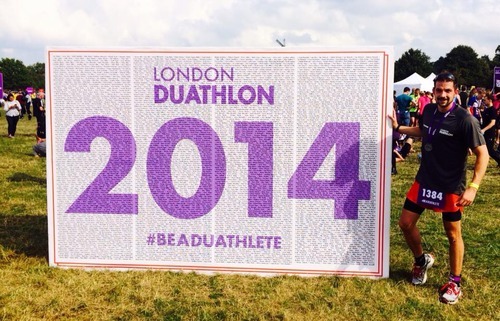
1 note
·
View note